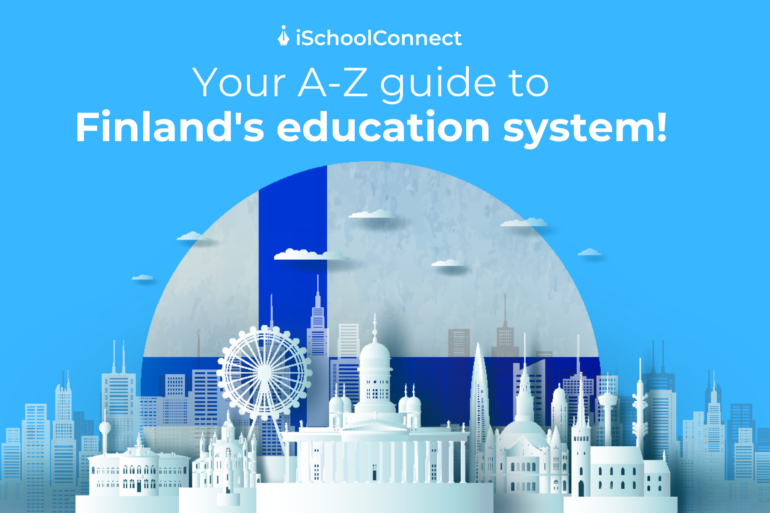Table of Contents
- Finland’s educational excellence
- Why Finland education system is the best?
- Minimal standardized testing
- Comprehensive teacher training
- Teacher autonomy
- Support for all students
- Shorter school days and less homework
- A strong focus on play
- A comprehensive welfare system
- Equal opportunities for all
- A balanced curriculum
- High teacher prestige
- A strong emphasis on professional development
- The role of parental involvement
- No private schools
- Key takeaways
- FAQs
Finland’s educational excellence
Praised for its innovative approach to teaching and learning, Finland’s education system has garnered international attention. This Nordic nation consistently ranks at the top in global education assessments, such as the Program for International Student Assessment (PISA). It measures student performance in mathematics, science, and reading. While the Finnish system has its challenges, there are several key developments that set it apart from other educational models around the world. In this blog, we will explore some of the remarkable features that make Finland education system stand out and how they contribute to its success.
Why Finland education system is the best?
As we discuss the features of Finland’s education system, we will uncover the key elements that make it a standout model, contributing to its reputation for excellence and success on the world stage.
Minimal standardized testing
One of the most notable aspects of Finland’s education system is the minimal emphasis on standardized testing. Unlike many other countries, where high-stakes tests can dominate the educational landscape, Finnish students face relatively few assessments. Instead, educators place a significant emphasis on individualized learning, allowing students to progress at their own pace. This approach promotes a deeper understanding of the material and encourages critical thinking rather than rote memorization.
Comprehensive teacher training
Another hallmark of Finland’s educational excellence is its rigorous teacher training programs. Becoming a teacher in Finland is a highly competitive and demanding process. Prospective educators have to necessarily complete a master’s degree in education, ensuring they have a deep understanding of the subject matter. This comprehensive training equips teachers with the skills and knowledge required to provide high-quality education to their students.
Teacher autonomy

In Finland, teachers enjoy a high degree of autonomy in the classroom. They are trusted to design their own curricula, assessments, and teaching methods. This autonomy allows teachers to adapt to their student’s unique needs and fosters a sense of professionalism and dedication among educators. The trust placed in teachers also encourages a commitment to continuous professional development.
Support for all students
Finland is famous for its commitment to inclusivity and support for all students, regardless of their background, abilities, or learning style. Special education services are widely available, and students who require additional support are integrated into mainstream classrooms to the greatest extent possible. This inclusive approach helps create a supportive and nurturing learning environment for all students.
Shorter school days and less homework
Students in Finland experience shorter school days and less homework compared to many other countries. The average school day lasts for approximately five hours, and students get minimal homework. This approach aims to reduce stress and allows students to engage in a balanced life outside of school. It emphasizes the importance of well-being and quality leisure time.
A strong focus on play
The Finnish education system recognizes the importance of play in children’s development. Early education prioritizes play-based learning, allowing young students to explore and discover their interests in a relaxed and enjoyable setting. This approach fosters creativity and a love for learning from an early age.
A comprehensive welfare system

Finland’s strong social welfare system complements its education system. This safety net ensures meeting students’ basic needs, such as nutrition, healthcare, and housing. By providing a secure and stable environment, the welfare system enables students to focus on their education without the distraction of unfulfilled needs.
Equal opportunities for all
Finland is popular for its commitment to providing equal educational opportunities for all students. The system emphasizes on reducing socioeconomic disparities, which is reflected in policies that allocate resources and support to schools in need. This approach helps level the playing field and ensures that every student has a fair chance to succeed.
A balanced curriculum
The Finnish curriculum places a strong emphasis on a well-rounded education. While math and science are important, so are subjects such as arts, music, and physical education. This balanced curriculum helps foster creativity and provides students with a comprehensive education that equips them for various career paths and interests.
High teacher prestige
Teaching is a highly respected profession in Finland, and educators often have high reputation in society. This prestige attracts talented individuals to the profession, creating a strong and motivated teaching workforce. It also encourages students to consider teaching as a desirable career option.
A strong emphasis on professional development
Professional development is a cornerstone of Finland’s education system. Teachers are encouraged and supported in their ongoing growth and improvement. Opportunities for collaboration, mentoring, and sharing best practices among educators are common. This continuous focus on development ensures that teachers stay updated with the latest teaching methods and research, benefiting both students and the educational community.
The role of parental involvement
Parental involvement is a critical element of Finland’s education system. Parents can freely engage with their child’s school, attend meetings, and actively participate in their child’s learning journey. This collaboration between parents and teachers promotes a strong support system for students. This ensures that their needs are met inside and outside of the classroom.
No private schools
In an unusual departure from many other countries, Finland has a small number of private schools. The majority of Finnish students attend public schools. This system reduces the disparities in the quality of education and helps maintain a high level of educational equality.
Key takeaways
- Finland’s education system consistently ranks at the top in global assessments such as PISA, showcasing its innovative and effective approach to education.
- Minimal standardized testing allows students to focus on deeper learning and critical thinking rather than rote memorization.
- Finland’s commitment to inclusivity and support for all students creates a nurturing and supportive learning environment.
- Shorter school days and limited homework aim to reduce stress and promote a balanced lifestyle for students.
- A balanced curriculum, high teacher prestige, and a focus on professional development contribute to the overall success of Finland’s education system.
If you found this blog informative and want to explore more about international education or have questions, please don’t hesitate to reach out to us. Click here to contact our team for further information or assistance with any queries you may have.
Liked this blog? Read next: Finland study visa: Quick guide to residency and process
FAQs
Q1. Are there grade levels in Finnish schools, and how are students assessed for progression?
Ans- While there are grade levels in Finnish schools, overall development is the basis for students’ assessment rather than rigid grade-based systems. Teacher assessments, along with a focus on individualized learning, guide students’ progression.
Q2. Are school uniforms necessary in Finnish schools, like they are in other European countries?
Ans- No, school uniforms are not required in Finnish schools. Students wear civil clothes, allowing for individual expression.
Q3. How does a school day look in Finland?
Ans- The Finnish school day begins between 9 and 9:45 a.m. and ends at 2pm, and children normally spend only around five hours per day in class.






